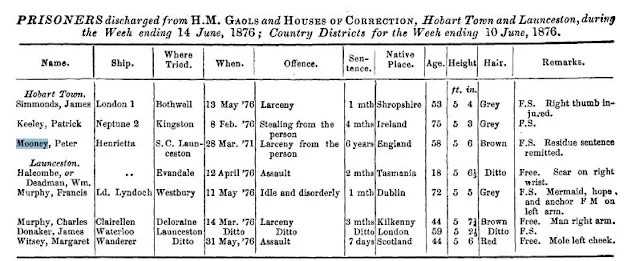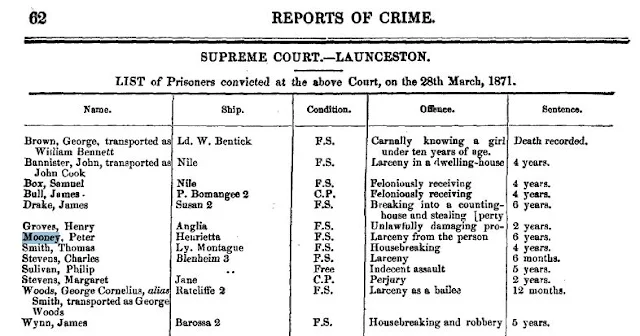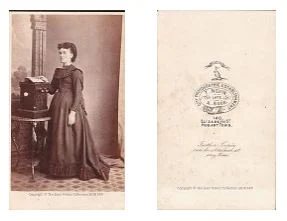NEVIN John snr, poetry and house at Ancanthe
NEVIN, GENGE and CHANDLER families, Glenorchy, Tasmania
Wesleyan Chapel, Kangaroo Valley, Tasmania
John NEVIN snr (1808-1887), Wesleyan, poet, teacher, journalist and Royal Scots veteran of the Canadian Rebellions 1837-38, arrived in Van Diemen's Land (Tasmania) with his wife Mary and four children as a pensioner guard on the Fairlie in July 1852. They settled on land adjacent to the Franklin Museum at Kangaroo Valley, New Town, near Hobart (renamed Lenah Valley in 1922) in 1854. The Valuation Rolls for Southern Tasmania listed his occupancy there from the 1850s to the 1880s of the school house, Wesleyan chapel and house on one acre, valued at five pounds - £5 - held by the Trustees of the Wesleyan Church.

John Nevin, occupier of the Wesleyan Chapel, school house, dwelling, and garden leased from Maria Nairn.
Hobart Valuation Rolls, Hobart Town Gazette, November 26, 1872. p. 1678
Source: Archives Office of Tasmania
By March 1859, the Trustees of the Wesleyan Church who owned the land had erected a new building for a Chapel and Sunday School.

Wesleyan Chapel and Sunday School opened at New Town
Launceston Examiner 26 March 1859
TRANSCRIPT
On Tuesday afternoon the new building erected at New Town, for a Chapel and Sunday School, in connection with the Wesleyans, was opened by a tea meeting, The Chair was taken by Samuel Crisp, Esq., and addresses were delivered by the Revs. Messrs Cope and Lelean [sic-McLean?], Messrs. Shoobridge, Brown, Crouch &. Divine service will be held every Sunday, and a Sunday School will be established.And again, from the Launceston Examiner 26 March 1859:

Wesleyan Chapel Back Road New Town
Launceston Examiner, 9 June 1859
TRANSCRIPT
Sermons were preached on Sunday on the occasion of the opening of the new Wesleyan Chapel, Back Road, New Town. The Rev. Mr. Quick, of Horton College, preached in the morning to a numerous audience, and the Rev. J. Cope in the afternoon. Mr. Quick again preached for the same object at Melville-street Chapel in the evening. Launceston Examiner, 9 June 1859Both the Franklin Museum, erected on the estate established by Jane Franklin, wife of Governor John Franklin, and still known as Ancanthe, and the Wesleyan Chapel, erected on land overlooking it, were situated on the Back Road, now Lenah Valley Road. Travellers on foot and horseback utilised the Back Road, which ran along the New Town Rivulet from the Main Road (New Town Road) to access Kangaroo Valley Bottom, and from there over the foot hills of Mount Wellington, to reach South Hobart.
John Nevin snr taught children at the school house by day and adult males by night. By 1854 he had built a new cottage on the land, which he celebrated in a poem titled "My Cottage in the Wilderness."

"My Cottage in the Wilderness" by John Nevin, 1868.
Mitchell Library State Library NSW
Photo © KLW NFC Imprint 2009
His eldest son Thomas J. Nevin (1842-1923), by then aged 26 yrs with a successful photographic business at 140 Elizabeth St. Hobart Town, photographed his parents at the front of the house.


Scans courtesy of Liam Peters 2010
The cottage that John Nevin built at Kangaroo Valley
"T.J. Nevin Photo" inscribed on verso, ca. 1868.
From © KLW NFC Imprint & The Liam Peters Collection 2010.
On July 12, 1871, John Nevin's eldest son Thomas, married Elizabeth Rachel Day (1847-1914) at the Wesleyan Chapel, Kangaroo Valley. Elizabeth Rachel Day was the eldest daughter of master mariner Captain James Day and Rachel Pocock, and niece of merchant mariner Captain Edward Goldsmith.
In 1872, John Nevin leased an additional acre of land nearby for gardens and orchards from Maria Nairn, wife of William Edward Nairn (1812-1869), assistant comptroller of the Convict Department in 1843, in charge of the prisoners in Tasmania and Norfolk Island, and sheriff of Hobart in 1857-68. His wife Maria Nairn was a sister of John Swan, Inspector of Police in the 1870s.
The Electoral Rolls and Valuation Rolls for the district of Glenorchy, Tasmania show John Nevin occupying the school house and dwelling at Kangaroo Valley from at least 1858 up to 1887, the year of his death. In 1875, he applied to the Education Board to establish a night school for adult males. The Tasmanian Museum and Art Gallery holds numerous stereographs of the school house at Kangaroo Valley taken by his son Thomas J. Nevin, e.g. :

TMAG Catalogue (2006)
Q16826.1.2 ITEM
MEDIUM: albumen silver print sepia toned stereoscope,
MAKER: T Nevin
TITLE: 'School House KangarooValley'
DATE: 1860s
DESCRIPTION : This photo depicts three adults and four children at Kangaroo Valley (LenahValley)
INSCRIPTIONS & MARKS: A Pedder
Death of Mary Ann Nevin (1810-1875)
John Nevin's wife Mary Ann ee Dickson died suddenly on 13th April 1875. She predeceased her husband John Nevin by 12 years, leaving three surviving children - Thomas James, Mary Ann and Jack (William John).The other daughter Rebecca Jane had died at Kangaroo Valley in 1865. Her death notice stated her residence as the Wesleyan Chapel, Kangaroo Valley:

Death notice for Mary Nevin (1810-1875)Mercury, 15 April 1875:
TRANSCRIPT
NEVIN- On the 13th April, at her residence, the Wesleyan Chapel, Kangaroo Valley, Mary, the beloved wife of John Nevin, in the 65th year of her age. The funeral will move from her late residence, on Friday, at 3 o'clock sharp, when friends are respectfully requested to attend.

Last entry; death of Mary Nevin, 13 April 1875, from bladder complications.
Described as "farmer's wife". Source: Archives Office of Tasmania
Thomas took this photograph ca 1873 of his mother Mary Ann Nevin (nee Dickson) a few years before her death, along with a companion photograph of his father John Nevin snr. These particular images of Mary Ann Nevin (mother) and John Nevin (father), are scans from uncut sepia prints which had been pasted into the scrapbook of Thomas Nevin's son George Nevin, now held in the Shelverton Family Collection.



Thomas Nevin's photographs of his parents Mary and John Nevin ca. 1873
From © KLW NFC Imprint and Shelverton Collections 2007-2012
Martha Genge (1833-1925)
Four years later, now a widower, John Nevin remarried. He was 71 yrs old when he married widow Martha Salter nee Genge, 46 yrs old, in Hobart, on the 23rd October, 1879. (Source: Tasmanian Pioneer Index: 711/1879/RGD:37).
John Nevin's second wife Martha Genge became step mother to his two surviving children by 1879 - his sons photographer Thomas James Nevin and Constable John (William John aka Jack Nevin). Their only surviving sister Mary Ann who had married John Carr, son of the late Captain James Carr, at the Wesleyan Chapel, Kangaroo Valley, on May 12, 1877, died shortly after childbirth aged 34 yrs on July 27, 1879 at her residence, Sandridge, Victoria. The child, a daughter named Mary Ann Carr survived and was taken back to Hobart to live with her grandfather John Nevin snr.
Martha Salter nee Genge was one of two daughters of Mary Genge (nee Slade) and William Genge, lay preacher at the Wesleyan church, Melville Street, Hobart. The discrepancy between their ages at the time of their marriage in 1879 - John Nevin was 71, Martha Salter nee Genge was 46 - may indicate an in loco parentis gesture on his part towards his deceased daughter's child, Mary Ann Carr.

Wesleyan preacher William Genge and wife Mary Genge nee Slade late 1870s
Parents of John Nevin's second wife, Martha Genge (1833-1925).
Hobart, Tasmania. Unattributed.
Photo courtesy and copyright of Louise Genge 2007.
Copies of the original photographs (minus versos or attribution) taken at the time of the marriage between John Nevin, aged 71 yrs, and his second wife Martha Genge, aged 46 yrs, are held at the Tasmanian Archives and Heritage Office, deposited by the Drew family on the death of John Nevin's grand daughter Minnie Drew nee Nevin (1884-1974), youngest daughter of Thomas and Elizabeth Nevin.

TAHO Ref: NS434/1/155
Photo by his son Thomas J. New Town studio 1879
Above: John Nevin senior (1808-1887), photographed in 1879, aged 71 years, on the occasion of his marriage to his second wife, Martha Genge (aged 46 yrs).


TAHO Ref: NS434/1/194
Photo by Thomas J. New Town studio 1879
Photos copyright KLW NFC ARR
Above: Martha Nevin nee Genge, photographed in 1879, aged 46 years, on the occasion of her marriage to her second husband John Nevin (aged 71 yrs).

"Married in the residence of Mr James Genge Kangaroo Valley"
Witnesses: James Genge, F. R Alomes
Name: Nevin, John
Record Type: Marriages
Gender: Male
Age:71
Spouse: Salter, Martha
Gender: Female
Age:46
Date of marriage:23 Oct 1879
Registered: Hobart
Registration year:1879
Document ID:NAME_INDEXES:888757
ResourceRGD37/1/38 no 711
On the 17th January 1881, Martha Genge's father William Genge died at the Wesleyan Chapel, Melville-street, Hobart, aged 73 yrs. John Nevin snr wrote and published a lament titled -
"Lines written on the sudden and much lamented death of Mr William Genge who died at the Wesleyan Chapel, Melville-street, Hobart on the morning of 17th January 1881, in the 73rd year of his age."

Title: Lines written on the sudden and much lamented death of Mr. William Genge, who died at the Wesleyan Chapel
Author/Creator: Nevin, J.
Publication Information: Hobart : Pratt, printer, 1881.
Physical description: 1 sheet.
Record ID: SD_ILS:542990
Allport Library Pamphlets P 820.A NEV
Six years later, John Nevin (1808-1887) died in the gardens of his much beloved cottage at Kangaroo Valley on 9th October 1887. His obituary was published in the Mercury on 11th October:
OBITUARY: John NEVIN (1808-1887)
TRANSCRIPT
DEATH OF AN OLD VETERAN.- There passed away very quietly on Sunday, 9th inst., at the good old age of 79, Mr. John Nevin, who for the last 30 years has lived in the secluded shades of Kangaroo Valley, adjoining Lady Franklin's old Museum. He lived a retired life on his pension and in working his plot of garden ground at the Wesleyan Chapel, enjoying the respect of all in the neighbourhood as a consistent Christian. His latter days were spent in quietness among his family, and he leaves a widow (a second wife) and two sons and several grandchildren in Hobart. Only a fortnight ago two friends of his, who were boys in the Royals, and had known him in Canada 50 years ago, paid him a visit, and a pleasant time was spent with him in recounting feats of valour long since almost forgotten. He was then enjoying good health, but last Wednesday, while working in his garden, he felt tired, and rested awhile on the damp ground, which caused a chill. He took to his bed, and, after three days' sickness, quietly joined the majority. In his day he was a wielder of the pen as well as of the sword, and was some 50 years ago a contributor to the infant Press in London, Canada West, when the present city of that name was a struggling town of rough and rude buildings and log huts. As a soldier of the Royal Scots he served under his colonel, Sir G.A. Wetherall, and the present Sir Daniel Lyons [i.e. Lysons] was his ensign; and he did his duty in very stirring times in the Canadian Rebellion of 1837-1838. He was engaged in the storming and capture of St. Charles and St. Eustache and in engagements of St. Dennis, St. Benoit, and many other operations on the Richelieu River and adjacent country of Chambly, and at Terra-Bone [i.e. Terrebonne] he assisted in the capture of a large number of French prisoners during a severe winter campaign, often struggling with his comrades to the waist in snow in following his officers in the work of quelling the rebellion of Papineau. John Nevin's proudest boast was that he had been a soldier of the Royals.Source: Hobart Mercury, 11 October 1887.
This photo was taken of his widow Martha Nevin nee Genge ca. 1887-1890. After John Nevin's death, she left the Kangaroo Valley cottage which was demolished by the Christ College Trustees of the Wesleyan Church and the Lady Franklin Museum on termination of his tenure, and moved to Patrick Street before taking up residence at the house of her brother J. Genge in Bowden St. Glenorchy where she died in 1925.

Martha Nevin nee Genge widow of John Nevin, taken ca. 1887-1890
Archives Office of Tasmania Ref:NS434/1/194
By the early 1920s, Martha Genge (1833-1925) was in her late eighties when her nephew James Chandler photographed her with his mother, Mary Chandler nee Genge.

Martha Nevin nee Genge ca. 1920
Archives Office of Tasmania Ref: NS434/1/248

Martha Nevin nee Genge on left, Mary Genge her sister on right.
Mary Genge married William Chandler in 1868 at the New Town Methodist Church.
Photos copyright KLW NFC 2012.
Source: TAHO Ref: NG1231
Title: JAMES CHANDLER, PHOTOGRAPHER
Start Date: 01 Jan 1910
End Date: 31 Dec 1935
James Chandler was a Hobart photographer. For many years he was a member of the Photographic Society and well-known on the Hobart waterfront as a marine photographer in the 1930's and 1940's. He was the youngest son of William Chandler, a bootmaker, and his wife Mary (nee Genge), the first couple married at the New Town Methodist Church on the 14 Jan 1868. His uncle was Jacob Chandler, a ship builder in Battery Point. He died in Hobart on 8 July 1945 and was cremated at Cornelian Bay 9 July 1945 aged 67, having been born on the 12 August 1877 in Hobart
Information Sources: Mercury 30 March 1945 p16

Photographer: James Chandler
Archives Office of Tasmania Ref: NS434/1/103
Martha Nevin nee Genge (left) and her sister Mary Chandler nee Genge (right) at Mt Stuart, Hobart, ca. 1920.
A short notice reporting the death of Martha Genge appeared in the Mercury 9 March 1925, with incorrect information. It stated she was the relict of William Nevin: she was the relict of the late John Nevin snr, father of photographer Thomas J. Nevin.

TRANSCRIPT
NEVIN. -On March 7, 1925, at the residence of her brother (Mr. J. Genge), Boden [sic- should be Bowden]-street, Glenorchy, Martha, relict of the late William [sic - should be John] Nevin, in the 92nd year of her age.Source: Family Notices. (1925, March 9). The Mercury (Hobart, Tas. : 1860 - 1954), p. 1.
Link: http://nla.gov.au/nla.news-article23802630
The Genge family orchards at Glenorchy
James Chandler took this photograph and others of the Genge family house and orchards at Glenorchy (Hobart, Tas) ca. 1910.

Source: Archives Office of Tasmania Ref: NS8691456-9

Title: Photograph - Glenorchy - home of the Genge family
Description: 1 photographic print
Format: Photograph
ADRI: NS869-1-457
Source: Archives Office of Tasmania



Burial Records

Martha Nevin Burial Record: Cornelian Bay Cemetery
Martha Nevin died in Hobart in 1925, born Martha Genge, 1833, Somerset, England. She married John Nevin in 1879 with the name Martha Salter. Her gravestone at Cornelian Bay (Southern Regional Cemetery Trust) reads:
"Martha Nevin, daughter of William and Mary Genge."
John Nevin died of pleurisy on October 8th, 1887: his death certificate recorded that he was a gardener.

Archives Office Tasmania: RGD 35/11 No. 1000
Text and photos copyright © KLW NFC Imprint 2012

























.jpg)
